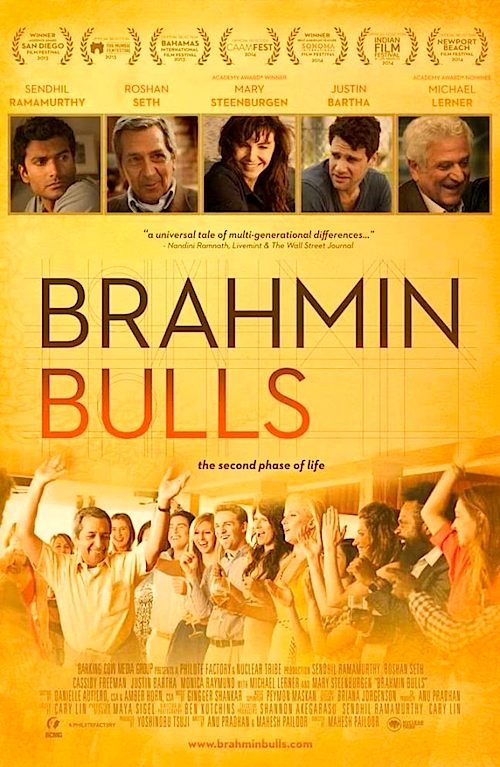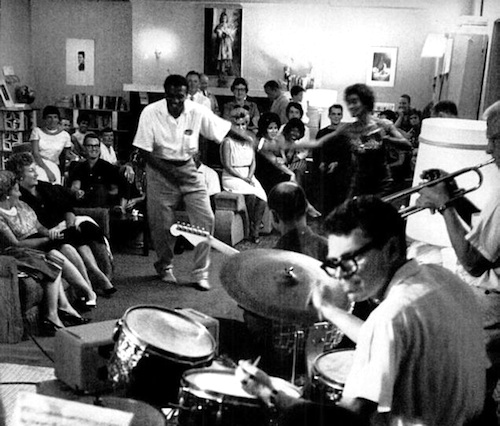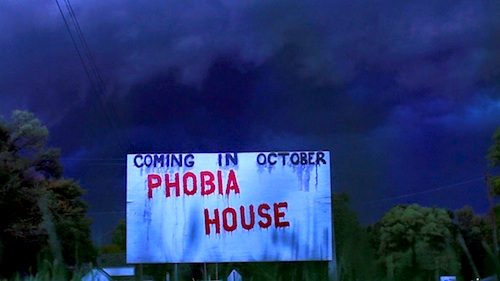By Joe Bendel. Ashok Sharma once had grand ambitions of winning a Nobel Prize. Father of the Year, not so much. He came up empty on both counts. Sharma will try to reconnect with his grown architect son, but another face from his past will complicate matters in Mahesh Pailoor’s Brahmin Bulls, which opens this Friday in New York.
Sharma lives in Boston, but he doesn’t seem like such a bad guy. Nevertheless, Sid Sharma considers himself more of the heir to Richard Neutra than his father’s son. Unfortunately, that is not what clients are looking for, thereby causing him stress in his firm. (Frankly, he probably ought to feel a little heat, since it looks like he plays tennis all day and gets smashed in hipster bars every night). Dr. Sharma will use an academic conference as a pretext for visiting his more-or-less estranged son, but he might have an additional ulterior motive. It turns out his former mistress, Helen West, will be one of the conference speakers.
 As viewers might expect, the reunion starts out massively awkward, but steadily thaws before getting predictably uncomfortable again. However, Pailoor skips the clichéd old world vs. new world clash of cultures. Frankly, the senior Sharma is just as westernized and modernized as his soon-to-be divorced son, if not more so. In fact, one of the most intriguing aspect of this film is the treatment of his arranged marriage (to Sid’s late mother, whom he cheated on). Obviously, it was a difficult marriage and he justly blames himself for the worst of it, but it is not like it was his idea in the first place. Indeed, it is rather complicated.
As viewers might expect, the reunion starts out massively awkward, but steadily thaws before getting predictably uncomfortable again. However, Pailoor skips the clichéd old world vs. new world clash of cultures. Frankly, the senior Sharma is just as westernized and modernized as his soon-to-be divorced son, if not more so. In fact, one of the most intriguing aspect of this film is the treatment of his arranged marriage (to Sid’s late mother, whom he cheated on). Obviously, it was a difficult marriage and he justly blames himself for the worst of it, but it is not like it was his idea in the first place. Indeed, it is rather complicated.
There is an awful lot of standard issue father-son melodrama in Brahmin (tennis, the game that pulled them apart might just bring them back together). Still, distinguished screen actor Roshan Seth (Nehru in Gandhi and villain Chattar Lal in Indiana Jones and the Temple of Doom) is refreshingly dignified and understated as Dr. Sharma. He and Sendhil Ramamurthy play off each other rather well, as father and son. For comic relief, Michael Lerner is a lot of fun hamming it up as his formerly hard-partying academic colleague, while Mary Steenburgen also hits the right note of graceful resignation as West. On the other hand, Sid’s office and social network seems to be populated with an awful lot of boring characters.
Be that as it may, you have to give credit to a film that loudly proclaims it love for Neutra’s houses. Even if Brahmin follows a formulaic narrative, it is far less manipulative and sentimental than its themes would suggest. There is nothing particularly special about its technical package, but at least the admirably restrained Pailoor keeps it moving along, so it goes down relatively smoothly overall. No cause for fireworks, but those looking for emerging talent might want to check it out, because Pailoor could well be building towards bigger and better things with subsequent films. It opens tomorrow (11/14) in New York at the AMC Empire.
LFM GRADE: C+
Posted on November 13th, 2014 at 1:49pm.







